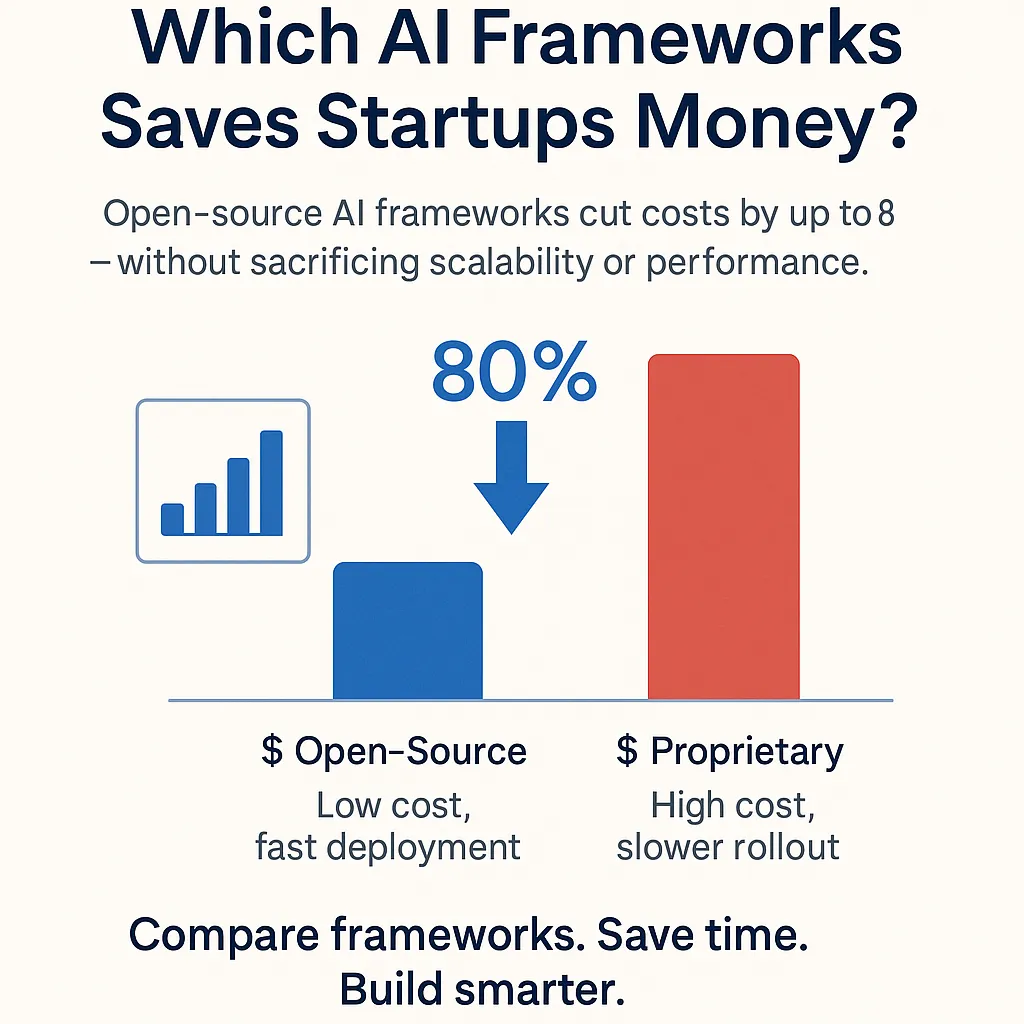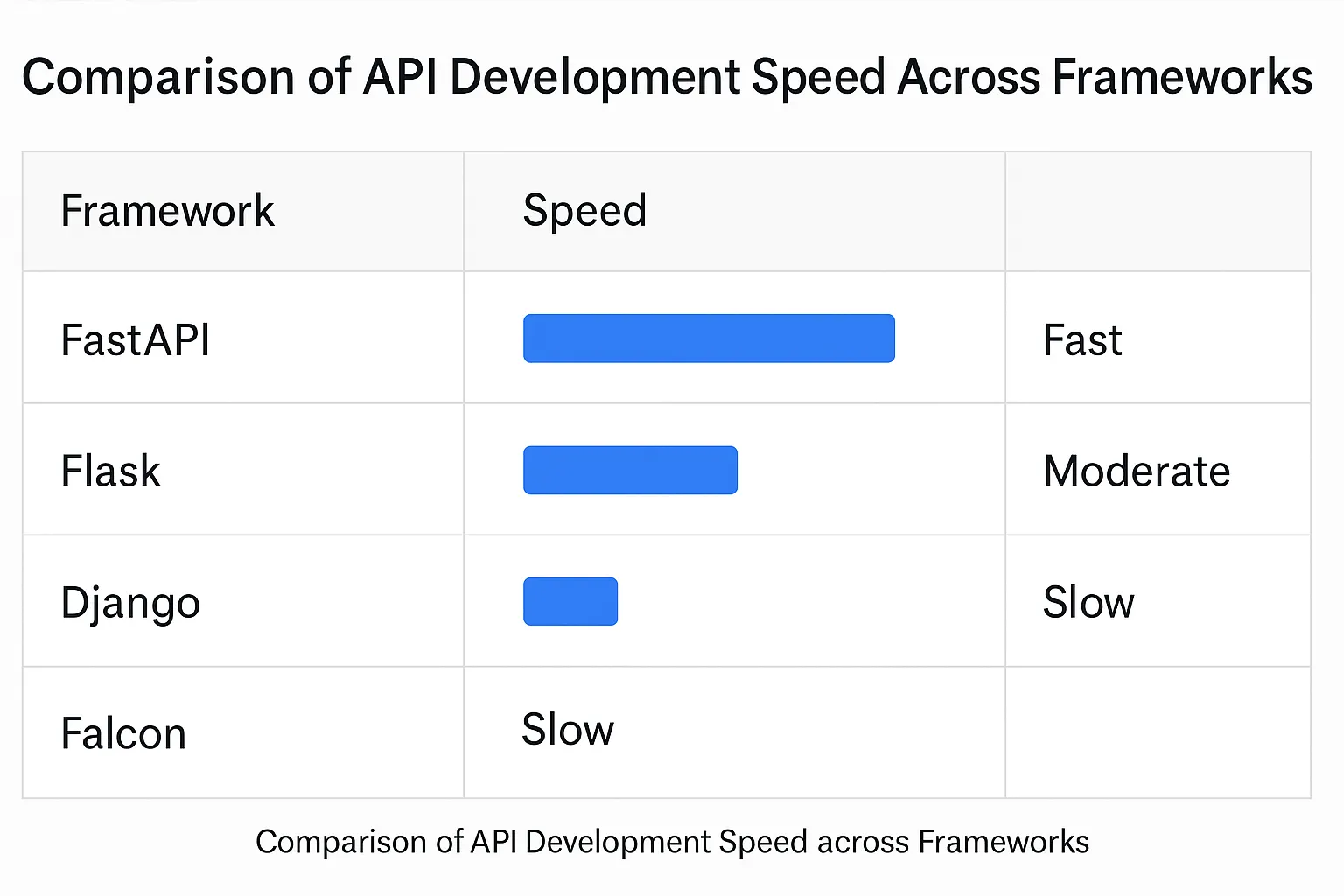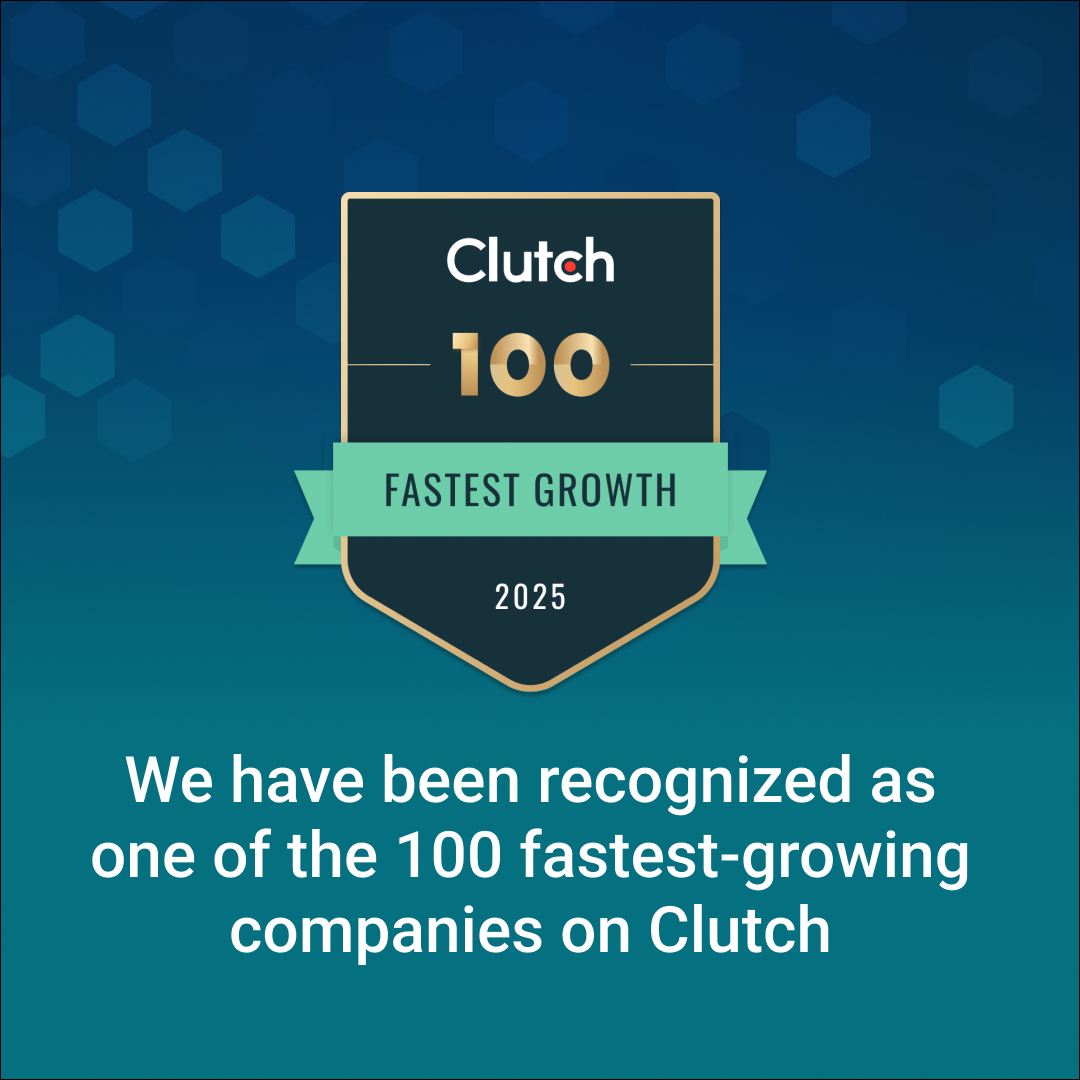Open-source AI frameworks cut startup development costs by 60-80% while delivering enterprise-level capabilities. Yet most startups still fumble around choosing the right framework when facing brutal budget constraints and impossible deadlines.
You’re probably weighing expensive proprietary solutions against free tools, wondering which frameworks will actually help you ship faster without breaking the bank. The wrong choice here can mean months of wasted development time and resources you simply don’t have.
This guide breaks down the top AI frameworks specifically for cash-strapped startups, complete with real implementation costs, timeline data, and proven strategies from teams who’ve shipped successful AI products on shoestring budgets. Organizations are increasingly adopting cloud technologies, and we’ll show you exactly how to leverage this shift for maximum cost efficiency.

Fig1. Cost differences between open-source vs proprietary AI frameworks
Your Best Bet for Fast, Cheap AI Development
Startups facing budget and time constraints should prioritize TensorFlow Lite, Hugging Face Transformers, and FastAPI for rapid AI development. These frameworks reduce development timelines significantly while cutting costs substantially compared to custom solutions.
Key takeaways:
- Open-source frameworks eliminate licensing fees entirely
- Pre-trained models accelerate development by weeks or months
- Cloud-native deployment keeps infrastructure costs minimal
- API-first development enables parallel team workflows
Framework Selection Criteria: What Actually Matters When You’re Broke
The math is simple: open-source frameworks eliminate licensing fees and reduce total development costs by 60-80% compared to proprietary solutions. This isn’t just about saving money upfront (though that matters when you’re counting every dollar). You’re also buying yourself flexibility to pivot without getting locked into expensive vendor contracts.
Frameworks with extensive pre-built models and components accelerate development significantly. Think about it: instead of spending months training models from scratch, you can fine-tune existing ones in days. This speed advantage becomes critical when you’re racing to prove product-market fit before your runway disappears.
Consider these factors when selecting your framework:
- Learning curve for your team – Python-based frameworks typically offer the shortest ramp-up time
- Deployment requirements – Cloud-native frameworks reduce infrastructure complexity
- Community support – Strong ecosystems accelerate problem-solving
- Long-term viability – Choose widely-adopted frameworks to avoid technical debt
Cloud-native frameworks reduce infrastructure complexity and operational costs, while serverless-compatible options can eliminate server maintenance expenses entirely. When only 28% of IT budgets are allocated to innovation (the rest goes to maintenance), choosing low-overhead frameworks becomes absolutely crucial.
Top AI Frameworks That Won’t Break Your Budget
TensorFlow Lite: Mobile-First AI That Actually Works
TensorFlow Lite stands out for mobile-first AI solutions. TensorFlow Lite reduces mobile app model size by up to 75% and runs efficiently on devices with minimal RAM requirements. This matters because mobile optimization directly impacts user experience and app store rankings.
Pre-trained models for common use cases like image classification and natural language processing are readily available, meaning startups can implement core AI functionality within days rather than months.
Key benefits:
- Massive model size reduction for mobile deployment
- Runs on resource-constrained devices
- Extensive library of pre-trained models
- Google’s backing ensures long-term support
Hugging Face Transformers: The NLP Powerhouse Everyone’s Using
Hugging Face Transformers dominates the NLP space with over 100,000 pre-trained models and rapidly growing adoption across the industry. Access to ready-to-deploy models lets startups launch sophisticated AI features with minimal engineering effort.
The framework supports both PyTorch and TensorFlow backends, providing flexibility for existing tech stacks. Teams can leverage familiar tools while accessing cutting-edge language models without the massive compute costs of training from scratch.
Why startups love it:
- Thousands of pre-trained models ready to use
- Multi-framework compatibility
- Strong community and documentation
- Easy fine-tuning for domain-specific needs
FastAPI: Build Production-Ready AI APIs Fast
FastAPI enables developers to build production-ready AI APIs significantly faster than traditional frameworks. Automatic documentation generation reduces development overhead, while built-in async support handles high-concurrency scenarios efficiently without additional infrastructure investment.

Fig2. API development speed across different frameworks
Deploying machine learning models with FastAPI and Hugging Face transformers enables rapid, production-ready API development with significantly reduced development overhead. NLP Cloud, which operates a production NLP API serving hundreds of Hugging Face transformer models for entity extraction, text classification, sentiment analysis, question answering, and summarization, adopted FastAPI coupled with Uvicorn ASGI server specifically because of its high performance and suitability for serving transformer-based deep learning models—demonstrating that FastAPI provides the architectural foundation needed for efficient machine learning API serving that would otherwise require substantially more effort with traditional frameworks, while developers building secure AI applications integrate FastAPI with LangChain and Hugging Face transformers to create production endpoints with JWT authentication, model orchestration, and natural language processing capabilities, eliminating the complexity and development time associated with building such systems from scratch.
Budget Optimization Strategies That Actually Work
Leverage Pre-Trained Models (This Is Non-Negotiable)
Using pre-trained models can reduce development costs by 70-90% compared to training custom models from scratch. Fine-tuning existing models requires significantly less computational resources and expertise, making advanced AI accessible to resource-constrained teams.
Transfer learning techniques allow startups to achieve enterprise-level AI performance with minimal data and compute requirements. Industry reports show startups can fine-tune domain-specific models with as little as 2,000 rows of data, achieving strong accuracy at minimal cost.
Cost breakdown for pre-trained model approach:
- Initial model: $0 (open source)
- Fine-tuning compute: $100-500
- Deployment: $10-50/month initially
- Custom training alternative: $10,000-50,000+
Cloud-First Strategy: Pay Only for What You Use
Cloud platforms offer pay-as-you-scale pricing models that align costs with startup growth phases. Cloud AI costs for prototypes can start under $50 per month using free or low-tier options, scaling only with usage as the startup grows.
Managed AI services eliminate the need for specialized DevOps expertise and infrastructure management, letting startups focus resources on core product development. Industry data shows 85% of new AI startups started cloud-native in recent years, reflecting the practical reality that bootstrapped startups simply can’t afford the alternative.
Timeline Acceleration: Ship Fast or Die
Low-Code Platforms for Rapid Prototyping
Low-code AI platforms can reduce initial prototype development time from weeks to days. Visual development interfaces accelerate iteration cycles significantly, though you’ll want to be careful about vendor lock-in with proprietary platforms.
Best practices for rapid prototyping:
- Start with MVP scope – Focus on core AI functionality only
- Use API-first development – Enables parallel frontend/backend work
- Prioritize user feedback loops – Validate before adding complexity
- Plan for iteration – Build modular architecture from day one
API-First Development Changes Everything
API-first development allows parallel frontend and backend development, cutting overall timeline by substantial margins. Teams can work simultaneously on different components without dependencies, which becomes crucial when you’re trying to prove concepts quickly.
As noted in lean startup methodology, MVP-focused AI prototyping prioritizes must-have features and avoids overengineering, validating real user needs first.
AI MVPs succeed when teams scope tightly and iterate fast based on real user data, identifying the minimum viable AI feature—the smallest feature that requires AI and delivers value—while stripping away nice-to-haves and focusing on what the AI must do to prove the concept, with everything else (UI polish, integrations, dashboards) deferred for later iterations, ensuring that projects avoid the overengineering trap where AI’s ease of feature generation risks adding unnecessary functionalities, with research showing that 42% of AI startup failures cite market misfit—a problem that MVP-driven validation prevents by prioritizing core features and gathering early adopter feedback before committing to full-scale development.
Low-code platforms combined with FastAPI enable rapid AI product development with production-ready performance. Building AI-powered applications with FastAPI, such as an AI customer assistant integrated with LangChain and Dremio, demonstrates how developers can rapidly prototype and deploy AI products that handle multiple concurrent requests efficiently—avoiding months of traditional backend development while maintaining enterprise-grade reliability and real-time interaction capabilities.
Discover which AI frameworks deliver the best value for startups—cutting deployment time and operational costs while accelerating real-world scalability and growth.
SmartDev’s AI engineering team benchmarks leading frameworks to reveal which options optimize compute efficiency, simplify integrations, and reduce technical debt from day one.
Learn how startups achieve faster MVP launches and long-term savings by aligning framework selection with business goals, resource constraints, and future scalability needs.
Start My AI Framework ROI ComparisonTeam Management: Getting the Most from Limited Resources
Documentation and Community Support Matter More Than You Think
Frameworks with extensive documentation and community support reduce onboarding time for new team members significantly. Strong ecosystem support accelerates problem-solving and reduces development blockers, which matters when you don’t have senior developers to mentor junior ones.
Building resilient small teams:
- Cross-train team members on multiple framework components
- Document architectural decisions early and often
- Establish code review processes from day one
- Plan for knowledge transfer before you need it
Strategic Outsourcing for Specialized Components
Outsourcing select AI components to vetted specialists can reduce end-to-end delivery time and lower total project costs. A hybrid approach—keeping core IP in-house while outsourcing complex AI components—often yields the highest speed and flexibility for resource-constrained startups.
 According to company reporting, strategic partnerships with AI development specialists provide enterprise-level expertise at startup-friendly rates. This hybrid model lets you maintain control over core business logic while accessing specialized skills you can’t afford to hire full-time.
According to company reporting, strategic partnerships with AI development specialists provide enterprise-level expertise at startup-friendly rates. This hybrid model lets you maintain control over core business logic while accessing specialized skills you can’t afford to hire full-time.
Scalability: Building for Growth Without Breaking the Bank
Microservices Architecture Pays Off Later
Microservices architecture enables significant reduction in operational costs through granular scaling capabilities. Research demonstrates that microservices support horizontal scaling with greater efficiency and lower cost compared to monolithic architectures—when demand increases for specific components, only those services need additional resources rather than replicating the entire application, optimizing resource utilization and preventing over-provisioning, with industry practice showing that service-based scaling eliminates the need to upscale entire applications, allowing teams to expand only the necessary components experiencing high demand, delivering substantial cost savings and operational efficiency through this granular resource allocation approach.
Key architectural decisions for scalable AI:
- Container-based deployment – Ensures consistent performance across environments
- API abstraction layers – Protects core logic from framework dependencies
- Monitoring from day one – Prevents costly optimization projects later
- Modular component design – Enables independent scaling and updates
Container-based deployment strategies ensure consistent performance across development and production environments. Industry data shows most cloud-native startups now use Docker/Kubernetes as standard, and this approach simplifies scaling decisions as user demand grows.
Future-Proofing Your Technology Stack
Framework selection should consider long-term ecosystem health and industry adoption trends. Relying on community-backed, modular AI frameworks provides insurance against obsolescence and costly rewrites down the road.
API abstraction layers protect core business logic from framework-specific dependencies, enabling technology transitions without complete rewrites. Abstraction patterns like the Anti-Corruption Layer encapsulate vendor-specific implementations behind domain-language interfaces, so switching payment processors, databases, or cloud providers requires changes only to the abstraction layer rather than throughout the entire system, allowing teams to evolve technologies incrementally while preserving business logic integrity.
Common Pitfalls That Kill Startup AI Projects
Technical Debt Will Destroy You
Rushing initial implementation without proper architecture planning can increase refactoring costs by 200-300%. Investing 15-20% of development time in architecture prevents expensive technical debt accumulation that could sink your startup later.
Avoid these deadly mistakes:
- Skipping performance monitoring setup
- Ignoring code documentation from the start
- Building monolithic architectures
- Choosing frameworks based on hype rather than needs
Regular code reviews and documentation practices cut cumulative technical debt significantly over the first two years. These practices become critical as teams scale and original developers transition (which happens frequently in startups).
Performance Optimization Can’t Be an Afterthought
Startups that baseline and monitor model performance early experience fewer surprise costs and outpace competitors when user volumes climb. According to SmartDev’s case studies, their customer care AI (VERA) was deployed with continuous monitoring, reducing response latency significantly post-optimization and boosting user retention metrics.
Early performance baselines help you make proactive scaling decisions and resource planning. Caching strategies and model optimization techniques can improve response times by 50-80% without additional infrastructure investment.
These optimizations directly impact user experience and retention rates, which matters more than fancy features when you’re trying to build a sustainable business. The key is building monitoring and optimization into your development process from the start, not treating it as an afterthought.
Ready to Build AI That Actually Ships?
For startups serious about implementing AI within budget and timeline constraints, SmartDev’s AI development services offer proven frameworks and methodologies that have helped hundreds of companies launch successful AI products. Their hybrid approach combines the speed of pre-built solutions with the customization your unique business needs.
Whether you need AI consulting to define your strategy or full-stack AI development, working with experienced partners can mean the difference between shipping on time and burning through your runway on technical experiments.
Learn more about SmartDev’s approach to startup AI development and how they’ve helped companies like yours turn AI concepts into profitable products.








